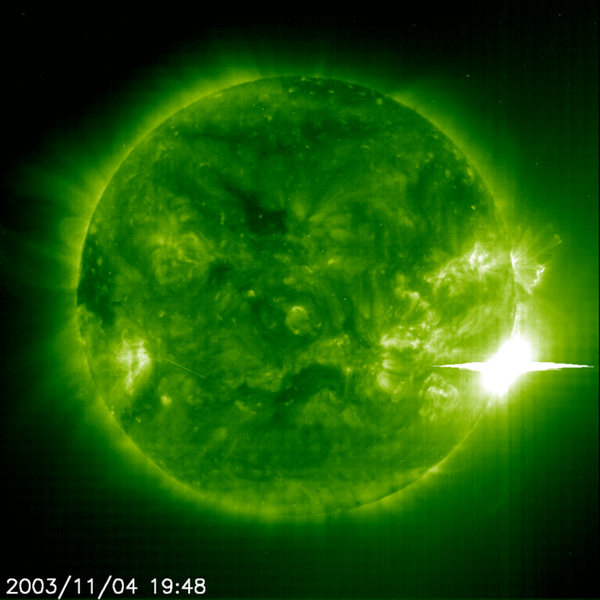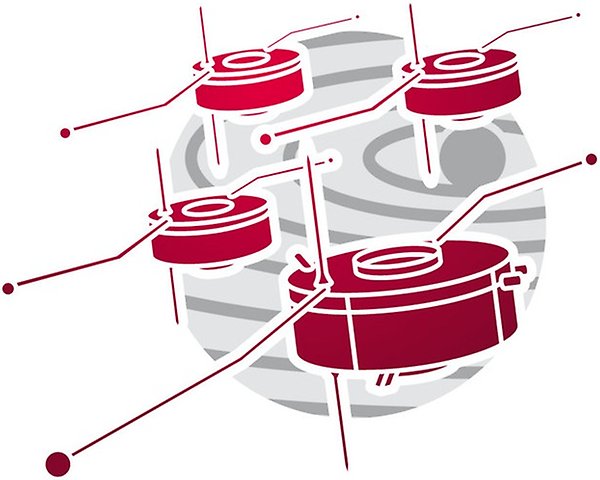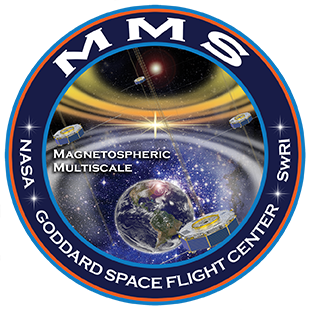Magnetic reconnection
Plasma is the most common state of matter in the observable Universe and can be described as a gas of charged particles exhibiting collective behaviour through electromagnetic fields. The plasma is often permeated by magnetic fields that can originate from stars, planets, other astrophysical objects or manmade devices. Magnetic reconnection is a fundamental plasma process that changes the magnetic field topology and converts magnetic field energy to kinetic energy of charged particles, heating and accelerating them, and allows for plasma transport across otherwise closed magnetic boundaries. It allows, for example, the solar wind to leave the corona of the Sun, and for the solar wind plasma to enter, the otherwise closed, planetary magnetospheres. Magnetic reconnection is a fundamental physical process that can occur in laboratory and fusion devices, on the sun and in the solar wind, in the planetary magnetospheres, supernovae, and other astrophysical environments.

Hot plasmas and energetic particles radiate electromagnetic waves in a wide frequency range. These waves can be observed remotely, as in the case of solar flares which are X-ray emissions from energetic electrons produced by magnetic reconnection in the solar corona. Credit: ESA
Spacecraft observations
The Earth’s magnetosphere is an excellent laboratory to study fundamental plasma processes such as magnetic reconnection. Magnetic reconnection occurs at both the dayside − at the magnetopause, the nightside − in the magnetotail, as well as polar regions − at the cusps. The Earth is currently orbited by several space missions that consist of more than one spacecraft, allowing us to study both temporal and spatial phenomena in great detail.
The mission which allowed us to significantly improve our knowledge about reconnection is the European Space Agency’s (ESA) Cluster mission, consisting of four identical spacecraft, that has been in orbit around the Earth since 2000. Each satellite carries a set of eleven instruments to study electric and magnetic fields, and charged particles. The spacecraft separation has been varied over the years, from 10 000 to 20 km, allowing to study processes of diverse scales. The Swedish Institute of Space physics (Uppsala) is the lead contributor of the Electric Fields and Waves (EFW) instrument on Cluster.

Cluster logo. Credit: ESA

MMS logo. Credit: NASA
The Magnetospheric Multiscale (MMS) mission is a new four-satellite mission, run by the National Aeronautics and Space Administration (NASA), and launched on 12 March, 2015. The mission is similar to Cluster, but will provide higher temporal resolution, 3D electric field measurements, as well as a smaller separation distance between the spacecraft, to try to answer what mechanism(s) are responsible for the breaking of the frozen-in condition and study the area where it occurs. The Swedish Institute of Space Physics (Uppsala) contributes to the spin-plane double probe (SDP) electric field instrument, which is part of the FIELDS instrument consortium on MMS.
Our research
Our research involves the study of processes related to the onset, development, and consequences of magnetic reconnection on the plasma environment by using spacecraft data and advanced numerical simulations. Topics include wave activity as a means to transfer energy, provide anomalous resistivity in a collisionless plasma and map the magnetic reconnection region [Norgren et al., 2012, Viberg et al., 2013, Graham et al., 2014], properties of the depolarisation fronts and bursty bulk flows that transport plasma away from the magnetic reconnection region [Khotyaintsev et al., 2011, Divin et al., 2015], plasma acceleration processes during magnetic reconnection [Vaivads et al., 2011], proper identification of magnetic nulls (the region of vanishing magnetic field where field lines reconnect), the electron dynamics [Graham et al., 2015] and the impact of cold ions on the magnetic reconnection process [André et al., 2010]. The results are important in order to understand how the Earth is affected by its near space environment, but can be also applied to fundamentally similar plasma environments throughout the Universe which are inaccessible to in situ measurements, as well as to plasma devices on Earth.

Artist illustration of magnetic reconnection in the Earth's magnetotail. Credit: ESA
Team
- Mats André studies the impact of cold ions on magnetic reconnection
- Andris Vaivads investigates suprathermal electron acceleration during magnetic reconnection
- Yuri Khotyaintsev works with wave activity and particle acceleration
- Daniel Graham studies wave activity and electron dynamics in the vicinity of magnetic reconnection sites
- Sergio Toledo-Redondo investigates the impact of cold ions on the magnetic reconnection process
- Cecilia Norgren studies small scale plasma waves in the vicinity of magnetic reconnection regions
- Elin Eriksson studies particle acceleration in 3D during magnetic reconnection in the magnetotail
Master and bachelor projects
There are good possibilities to do a master or bachelor thesis project at the Swedish Institute of Space Physics. Visit our website for project suggestions or contact us directly for further information.
References
André, M., Vaivads, A., Khotyaintsev, Y. V., Laitinen,T., Nilsson, H., Stenberg, G., Fazakerley, A., and Trotignon, J. G. (2010). Magnetic reconnection and cold plasma at the magnetopause. Geophysical Research Letters, 37:L22108.
Divin, A., Khotyaintsev, Y. V., Vaivads, A., and André, M. (2015). Lower hybrid drift instability at a dipolarization front. Journal of Geophysical Research (Space Physics), 120:1124–1132.
Graham, D. B., Khotyaintsev, Y. V., Vaivads, A., and André, M. (2015). Electrostatic solitary waves with distinct speeds associated with asymmetric reconnection. Geophysical Research Letters, 42(2):215–224.
Graham, D. B., Khotyaintsev, Y. V., Vaivads, A., André, M., and Fazakerley, A. N. (2014). Electron Dynamics in the Diffusion Region of an Asymmetric Magnetic Reconnection. Physical Review Letters, 112(21):215004.
Khotyaintsev, Y. V., Cully, C. M., Vaivads, A., André, M., and Owen, C. J. (2011). Plasma jet braking: Energy dissipation and nonadiabatic electrons. Physical Review Letters, 106:165001.
Norgren, C., Vaivads, A., Khotyaintsev, Y. V., and André, M. (2012). Lower Hybrid Drift Waves: Space Observations. Physical Review Letters, 109(5):055001.
Vaivads, A., Retinò, A., Khotyaintsev, Y. V., and André, M. (2011). Suprathermal electron acceleration during reconnection onset in the magnetotail. Annales Geophysicae, 29:1917–1925.
Viberg, H., Khotyaintsev, Y. V., Vaivads, A., André, M., and Pickett, J. S. (2013). Mapping HF waves in the reconnection diffusion region. Geophysical Research Letters, 40:1032–1037.
